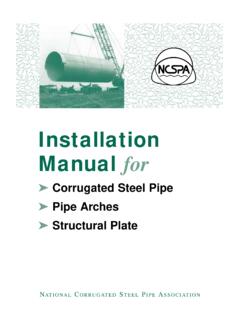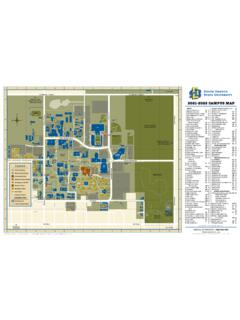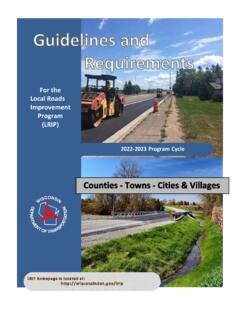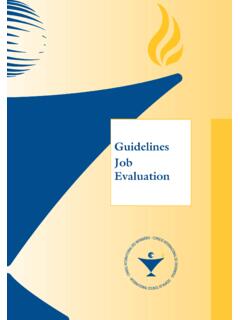Transcription of Rural Road Design, Maintenance, and Rehabitation Guide
1 SD95-16-G2 SD Department of Transportation Office of Research Rural Road Design, Maintenance, and Rehabilitation Guide Prepared by ERES Consultants, Inc. 505 West University Champaign, IL 61820-3915 September 1995 DISCLAIMER The contents of this report reflect the views of the authors who are responsible for the facts and accuracy of the data presented herein. The contents do not necessarily reflect the official views or policies of the South Dakota Department of Transportation, the State Transportation Commission, or the Federal Highway Administration. This report does not constitute a standard, specification, or regulation. ACKNOWLEDGMENTS This work was performed under the supervision of the SD95-16 Technical Panel: Ray Roggow .. Gregory County Roger Muller .. Turner County Hiene Junge .. Codington County Ken Skorseth .. South Dakota Technology Transfer Center Brett Hestdalen.
2 Federal Highway Administration Toby Office of Planning and Programming Joe Feller .. Office of Materials and Surfacing Terry Jorgensen .. Office of Local Government Assistance David Huft .. Office of Research Blair Lunde .. Office of Research i TECHNICAL REPORT STANDARD TITLE PAGE 1. Report No. 2. Government 3. Recipient's Catalog No. Accession No. SD95-16-G2 4. Title and Subtitle 5. Report Date Rural Road Design, Maintenance, and Rehabilitation Guide September 22, 1995 6. Performing Organization Code 7. Author(s) 8. Performing Organization Report No. Mr. Curt A. Beckemeyer and Mr. Trent J. McPeak 9. Performing Organization Name and Address 10. Work Unit No. ERES Consultants, Inc. 505 West University Avenue 11. Contract or Grant No. Champaign, Illinois 61820-3915 310348 12. Sponsoring Agency Name and Address 13. Type of Report and Period Covered South Dakota Department of Transportation Guideline Office of Research 14.
3 Sponsoring Agency Code 700 East Broadway Avenue Pierre, SD 57501-2586 15. Supplementary Notes The Rural Road Design, Maintenance, and Rehabilitation Guide (SD95-16-G2) is part of a series of three guides. The other two guides are the Rural Road Condition Survey Guide (SD95-16-G1) and the Rural Road Management Guide (SD95-16-G3). 16. Abstract The Rural Road Design, Maintenance, and Rehabilitation Guide was developed to provide the counties of South Dakota with an established, uniform set of guidelines for the design, maintenance, and rehabilitation of Rural roads. The guidelines address items such as roadway geometry (horizontal and vertical), typical roadway surface types, roadway surface design and repair, subgrade soils, and trench backfilling. The geometric-related guidelines are adapted from the SDDOT Secondary & Off-System Road plan and the 1990 American association of State Highway and Transportation Officials (AASHTO) manual, A policy on Geometric Design of Highways and Streets.
4 The geometry guidelines address design speed, roadway width, vertical grades, stopping sight distance, curvature, cross slope, superelevation, right-of-way (ROW) width, vertical clearance, and ditch slopes. The roadway surface-related guidelines pertain to the design, maintenance, and rehabilitation of the four types of roadway surfaces typically constructed on South Dakota s Rural roads gravel, blotter, asphalt concrete, and portland cement concrete. The guidelines describe the primary design and performance characteristics of each surface type, provide design thicknesses, identify various repair techniques, and discuss the applicability of each technique. In addition, guidelines for the inspection and testing of materials and construction activities are discussed. 17. Keyword 18. Distribution Statement No restrictions. This document is available to the public from the sponsoring agency.
5 19. Security Classification (of this report) Unclassified Security Classification (of this page) Unclassified 21. No. of Pages 64 n/a iii TABLE OF CONTENTS Page 1. 2. GEOMETRIC Introduction ..3 Geometric Requirements ..3 Design Speed ..7 Width of Roadway ..7 Vertical Grades ..7 Stopping Sight Distance ..7 Minimum Curve Radius/Maximum Degree of Curvature ..7 Pavement Surface Crown ..8 Superelevation ..8 Right-of-Way (ROW) Width ..8 Vertical Clearance ..8 Inslope ..9 3. TYPICAL ROADWAY SURFACE Gravel-Surfaced Roads ..11 Blotter (Chip Seal) Pavements ..11 Asphalt Concrete Pavements ..12 Portland Cement Concrete PCC Pavement Types ..14 Function of the Various Layers in a PCC Pavement ..15 4. GRAVEL ROAD DESIGN AND REPAIR ..17 Gravel Road Repair Options ..17 Typical Gravel Road Repair Techniques ..19 Surface Blading ..19 Regraveling.
6 21 Dust Control ..21 Cleaning Ditches ..21 New or Reconstructed Gravel Roads ..22 Typical Gravel Road Repair Frequency ..22 iv TABLE OF CONTENTS (continued) Page 5. FLEXIBLE PAVEMENT DESIGN AND Flexible Pavement Repair Options ..25 Flexible Pavements in Excellent Condition (Rating Value of 86 to 100) ..27 Flexible Pavements in Very Good Condition (Rating Value of 71 to 85) ..27 Flexible Pavements in Good Condition (Rating Value of 56 to 70) ..27 Flexible Pavements in fair Condition (Rating Value of 41 to 55) ..28 Flexible Pavements in Poor Condition (Rating Value of 26 to 40) ..28 Flexible Pavements in Very Poor and Failed Condition (Rating Value of 0 to 25) ..29 Flexible Pavement Repair Techniques ..29 Crack Sealing ..29 Pothole Patching ..32 Patching of Alligator-Cracked Areas ..32 Surface Treatments ..33 AC Overlays ..35 Partial-Depth Removal and Replacement of the AC Layer.
7 38 New Construction or Reconstruction of Flexible Pavements ..39 6. RIGID PAVEMENT DESIGN AND REPAIR ..43 Jointed Plain Concrete Pavement Repair Options ..43 JPCP in Excellent Condition (Rating Value of 86 to 100) ..43 JPCP in Very Good Condition (Rating Value of 71 to 85) ..45 JPCP in Good Condition (Rating Value of 56 to 70) ..45 JPCP in fair Condition (Rating Value of 41 to 55) ..45 JPCP in Poor Condition (Rating Value of 26 to 40) ..46 JPCP in Very Poor and Failed Condition (Rating Value of 0 to 25) ..46 Jointed Plain Concrete Pavement Repair Techniques ..46 Joint and Crack Sealing ..46 Partial-Depth Spall Repair ..48 Full-Depth PCC Patches ..49 Diamond Grinding ..50 AC Overlays ..50 Crack and Seat or Break and Seat Followed by an AC Overlay ..50 New or Reconstructed JPCP ..51 Jointed Plain Concrete Pavement Joints ..53 Longitudinal Joint Spacing.
8 53 Transverse Joint Spacing ..53 Joint Design ..54 v TABLE OF CONTENTS (continued) Page 7. SUBGRADE SOILS ..55 Design Considerations ..55 Construction Considerations ..57 Drainage ..60 Swelling Soils ..60 8. TRENCH BACKFILLING ..61 9. REFERENCES ..63 APPENDIX A SDDOT JPCP JOINT DETAILS INTRODUCTION 1 1. INTRODUCTION This document is the second in a series of three manuals produced for the South Dakota Department of Transportation. It is intended for use by county superintendents and other county roadway agency personnel within the State of South Dakota for the efficient selection of maintenance, rehabilitation, and reconstruction alternatives for Rural gravel, blotter, asphalt concrete (AC), and portland cement concrete (PCC) roads. The first manual, Rural Road Condition Survey Guide , provides a methodology for determining the condition of Rural paved and gravel-surfaced roads.
9 The third manual, Rural Road Management Guide , provides direction for establishing county-wide management systems for Rural paved and gravel-surfaced roads. The Rural Road Design, Maintenance, and Rehabilitation Guide was developed to provide the counties of South Dakota with an established, uniform set of guidelines for the design, maintenance, and rehabilitation of Rural roads. The guidelines address items such as roadway geometry (horizontal and vertical), typical roadway surface types, roadway surface design and repair, subgrade soils, and trench backfilling. The geometric-related guidelines are adapted from the SDDOT Secondary & Off-System Road plan and the 1990 American association of State Highway and Transportation Officials (AASHTO) manual, A policy on Geometric Design of Highways and Streets. The geometry guidelines address design speed, roadway width, vertical grades, stopping sight distance, curvature, cross slope, superelevation, right-of-way (ROW) width, vertical clearance, and ditch slopes.
10 The roadway surface-related guidelines pertain to the design, maintenance, and rehabilitation of the four types of roadway surfaces typically constructed on South Dakota s Rural roads gravel, blotter, AC, and PCC. The guidelines describe the primary design and performance characteristics of each surface type, provide design thicknesses, identify various repair techniques, and discuss the applicability of each technique. In addition, guidelines for the inspection and testing of materials and construction activities are discussed. 2 GEOMETRIC DESIGN 3 2. GEOMETRIC DESIGN Introduction The geometric design guidelines presented in this section are adapted from the SDDOT Secondary & Off-System Road plan agreement between the Federal Highway Administration (FHWA) and the South Dakota Department of Transportation, dated November 26, 1990. Where information on a certain topic was not available in the above reference, the AASHTO manual entitled A policy on the Geometric Design of Highways and Streets (AASHTO 1990) was used.














